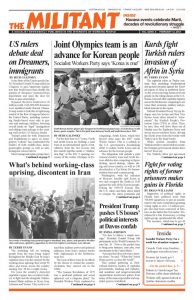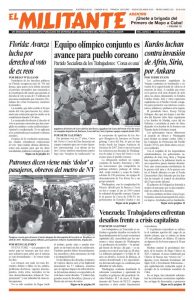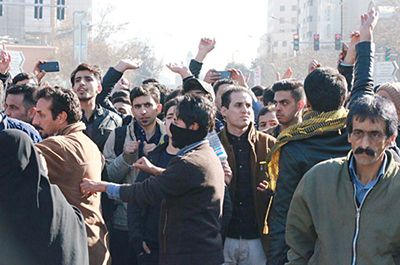The mounting toll on working people from the wars being waged throughout the Middle East by Iran’s capitalist class was the catalyst for the working-class uprising that swept 90 cities and towns across the country starting Dec. 28 for a couple weeks.
For years the country’s cleric-led capitalist regime has recruited workers to fight and die alongside Tehran-trained Shiite militias in Syria, Iraq, Lebanon and Yemen. They seek to extend their military power and political influence from Iran’s eastern border with Afghanistan to the Mediterranean Sea.
The roots of these wars lie in efforts by the clerics to extend the counterrevolution they carried out in the 1980s.
“The Iranian Revolution of 1979 was a profound political and social upheaval, not a religious jihad,” the Socialist Workers Party explained in its 2005 political resolution “Their Transformation and Ours,” reprinted in New International no. 12. “It became a deep-going, modern, popular social revolution in city and countryside, a revolution against the pro-imperialist monarchy of the shah and the brutal despotism of his hated SAVAK police agents. It opened space for workers and landless peasants, for women, for oppressed nationalities, for youth — for communists. It made possible the flowering of political space, debate, and culture that to this day are far from being taken away.
“The weight of religious figures and institutions grew stronger and more repressive as part of a political counterrevolution,” the party resolution said, “stifling in the name of Islam the rebellion of the most intransigent workers in the oil fields and factories, peasants on the land, Kurds and other oppressed nationalities, women fighting for equality, revolutionary-minded soldiers, students and other youth, and the boldest communists.”
The SWP had a sister party, then called the Socialist Workers Party, that participated in the Iranian revolutionary upsurge.
“The power and depth of that revolution is registered in the fact that the clerical-dominated bourgeois regime has never been able to come close to imposing suffocating political and cultural conditions of the kind the Taliban inflicted on Afghanistan or the Wahabi monarchists on Saudi Arabia,” the resolution said.
The clerical forces in Iran pushed aside weaker capitalist political figures not capable of taking on the workers and fought to ensure there were no inroads on capitalist rule. They organized gangs of thugs called Hezbollah — the party of God — to attack workers and others who opposed their rule.
As the capitalist regime sought to corral the workers at home, it simultaneously moved to advance its interests against rivals elsewhere, extending its counterrevolutionary sway against toilers in the region. The formation of the bourgeois party Hezbollah in the early 1980s in Lebanon, was a direct extension of the group of the same name in Iran that led assaults on workers’ organizations and political opponents.
Today the Iranian rulers utilize the Guards, its Quds special forces, Hezbollah and militias it funds and trains across Syria and Iraq. They have been at the forefront of propping up the hated Bashar al-Assad dictatorship, which has retaken large parts of Syria from those fighting to end his rule. Iranian-backed militias aided the Iraqi government’s expulsion of the Kurdish peshmerga from Kirkuk in October, dealing a blow to the struggle of Kurds for national rights. These armed units are now a formal part of the Iraqi Security Forces, reinforcing Tehran’s influence in that country.
Iranian rulers’ wars bred protests
The wars waged by the Iranian rulers today come decades after the consolidation of their counterrevolutionary rule. As fighting increased in Syria, and Assad’s dictatorship lost ground, the rulers in Tehran buttressed Hezbollah fighters with growing numbers of Iranian troops. At first the clerics said little about these moves in Iran’s press.
The carnage among the troops was deeply class-divided. As the number of workers coming home in body bags rose, Iran’s rulers erected monuments to those killed in working-class neighborhoods. Supreme leader Ali Khamenei and military figures visited the homes of families of those slain. The government broadcasts TV ads urging youth to “give their lives” in an effort to recruit more cannon fodder. The former mayor of Tehran was threatened with indictment last April when he spoke against military intervention in Syria and Yemen.
But opposition to the rulers’ wars and their deadly effect on the working class grew, and was widely expressed during the recent actions.
Working people in Iran view the government’s intervention in Iraq, Syria and elsewhere very differently from the war they waged against the U.S.-backed invasion of Iran by the Iraqi regime of Saddam Hussein in 1980. The Iraqi rulers then sought to crush the Iranian toilers and prevent them from advancing on gains made during the 1979 revolution.
Workers in Iran saw this war as their own, demanded military training and volunteered to fight in massive numbers. The country’s Arab and Kurdish population took part in the war effort. Working-class mobilizations gave a brief second wind to resistance to the clerics’ counterrevolution. An account of the political course and activity of the then-named Workers Unity Party of Iran — including its participation in the defense of the revolution against the Iraqi assaults — can be found in articles by Samad Sharif in New International no. 7.
The impact of capitalism’s wars, political repression and revulsion at the dog-eat-dog values advanced by the rulers has always been decisive in driving working-class action.
As workers respond to political questions, including the rulers’ wars, many become interested in how to overturn capitalist rule.
The capitalist rulers and their meritocratic promoters see themselves as more cultured than the working class. They share the view of Tehran cleric Kazem Sadighi that workers are “garbage.” But the working class has demonstrated that it is the political class. With the leadership necessary millions of working people engaged in revolutionary struggle and took power during the Bolshevik Revolution of 1917 and the Cuban Revolution of 1959.
It’s that capacity to take political action that lay behind the uprising in Iran and will fuel working-class mobilizations to come.


